Tires suck. They’re expensive, they’re always wearing out, and depending on where you live, you may need another set when winter rolls around.
But as frustrating as they are, tires are one of the most important parts of your car because they’re the only part that makes contact with the road. Without a good set of tires gripping the pavement, you can easily lose control of your vehicle or end up in an accident–especially if the weather is less than perfect.
Of course, accidents happen all of the time so it’s always good to take whatever measures you can to decrease the chances of one happening to you. You know that if you were driving carefully and your tires have good grip, the accident wasn’t your fault. If you do get into a car accident then it’s a good idea to contact an injury lawyer that can help you get compensation for any injuries you suffer. If the accident wasn’t your fault thanks to your sensible car maintenance, you shouldn’t have to pay for medical or repair bills.
So, given how crucial tires are, how do you get the most out of them? The answer is surprisingly simple: have your tires rotated.
The tires on your drive axle wear out the fastest. That means that if your car is front-wheel-drive, the front tires will be the first to go, if it’s rear-wheel drive, the rear tires will wear the quickest, and if your car is all-wheel-drive (not to be confused with four-wheel-drive), then the tires will wear somewhat evenly. This happens because the engine’s power puts more force on the tires that are supposed to get you moving, demanding more out of them. This is also why tires often wear out in pairs rather than just one at a time.
Front-wheel-drive cars even more stress on their tires. In those vehicles, the front tires deal with acceleration, braking, and steering. Tire rotations are a must for any vehicle, but that’s doubly true if yours is a front-wheel-drive (as the majority of cars are).
 Knowing when to get your tires rotated is important. Most repair facilities and many dealerships recommend you rotate your tires around every 10,000 km (6,200 miles). So, if your car runs on conventional or semi- synthetic oil, that means that you ought to have your tires rotated with every second oil change. If your car uses full synthetic oil, have them rotated with every oil change. It’s also a good idea to have them rotated if there’s a tread depth difference of more than 1/32″. You can easily check your tires’ treads using a tread depth gauge like the one shown here. You can pick up one for less than $5 at any auto parts store. Searching for auto supply coupons can help you get the best auto parts for your car at a reasonable and discounted price.
Knowing when to get your tires rotated is important. Most repair facilities and many dealerships recommend you rotate your tires around every 10,000 km (6,200 miles). So, if your car runs on conventional or semi- synthetic oil, that means that you ought to have your tires rotated with every second oil change. If your car uses full synthetic oil, have them rotated with every oil change. It’s also a good idea to have them rotated if there’s a tread depth difference of more than 1/32″. You can easily check your tires’ treads using a tread depth gauge like the one shown here. You can pick up one for less than $5 at any auto parts store. Searching for auto supply coupons can help you get the best auto parts for your car at a reasonable and discounted price.
Tire rotations aren’t crazy expensive either! Most repair facilities charge about $40 for the service, depending on the car. Some service packages, like a seasonal maintenance package, might already include a tire rotation in the price. Most of the shops where I’ve worked offer a tire protection package when you buy tires from them. This often includes a free rotation every year and free flat repairs. If you’re buying a set of new tires, don’t be afraid to ask the salesperson about those special deals.
Rotating your tires regularly can keep them from wearing out too quickly. Stay on top of it, and you could easily see your tires last for 50,000 km (31,000 miles) or more before they need to be replaced. Get the most out of your tires–and the money you’re investing in your car–by asking about a rotation next time you roll in for service.
